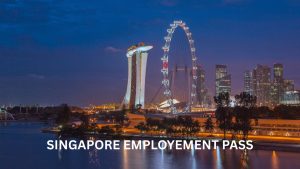Table of Contents
Introduction
If you keep up with the news, you must know how fast immigration rules are changing around the world. Many countries have revised their work visa policies.
Some countries are raising their salary thresholds for foreign employees, while others are tightening their eligibility requirements. In fact, some countries are also removing many previous rules regarding work visas altogether and introducing completely new procedures.
In this article, I have broken down the biggest visa changes across key countries and what they mean for workers planning to move abroad.
Work Visa Trends in the Past Years
The number of temporary work visa holders is increasing with every passing year. OECD countries gave out around 2.4 million of them last year. That’s 16% more than 2022 and way more than before COVID. This data clearly shows that countries need more workers. They are bringing in people because there aren’t enough locals to do all the jobs.
The U.S. is leading when it comes to work visas. According to a report I read, 1.2 million people got permission to work in the U.S. in 2024. That’s a huge number and shows just how much the American economy relies on foreign talent.
And even with all that, there’s still a massive waitlist. Nearly 785,000 people are approved for employment-based green cards but stuck waiting for a spot to open. To me, that backlog just proves the demand isn’t slowing down anytime soon.
All these numbers make one thing clear. Countries still want foreign workers. They just want to pick them carefully to match their economic needs. So they are changing rules to make sure only the best of the best can get into their country and contribute in a meaningful way.
Big Shifts in Work Visa Rules
There are a lot of changes happening with work visa rules this year. I have mentioned here a few of them:
- Higher Skill Requirement: Countries are looking for people with stronger qualifications or clear work experience. Just having a basic job offer isn’t enough anymore. Take the UK, for example, some jobs that used to qualify for sponsorship are now off the list unless they’re officially marked as shortage roles.
- Higher salary thresholds: In a lot of countries, the minimum salary to get a work visa is increasing. Governments say this helps make sure foreign workers are paid fairly. Another reason for doing this is to protect the salaries of local employees.
- Tougher checks on employers: Companies now have to show they tried to hire local workers first before they hired someone from abroad. This is done to keep the locals’ interest first. And it doesn’t stop there; even after a visa is approved, they need to keep following the rules.
Also Read: S Pass Criteria and Quota Guidelines for 2025
Country-Specific Work Visa Changes
I have listed here some of the major updates in the work visa process in some of the big economies of the world:
United Kingdom: Big Changes
Skills and Jobs: The UK’s skilled worker route now requires higher qualifications (RQF Level 6). There are also changes in the jobs that qualify for this visa. About 180 jobs may no longer qualify. Also, the Immigration Skills Charge went up 32% so employers also need to pay more.
Residency Rules: Getting permanent residence in the UK now takes up to 10 years. But if you can show you’re really contributing to the economy, there’s a way to get it sooner.
Pay and Language: The minimum salary required is increased to £38,700, and English requirements are stricter for visa holders and their dependents. The aim of these changes is to slow down migration numbers.
Germany: Skills Over Degrees
Germany is now more interested in what you can actually do than the fancy degree you hold.
Germany has opened 25,000 spots a year for short-term work in sectors that really need people. These jobs require at least 30 hours a week and must follow fair labour rules, so workers are protected.
Germany is also boosting opportunities for vocational training and professional recognition. These programs are up by more than half, which means more ways for skilled workers to settle in and work legally.
Australia: Skills in Demand
Australia has replaced its old shortage visa with a new one called the Skills in Demand visa. It has two main streams:
- Core Skills: Covers over 450 jobs that Australia really needs right now, like construction, healthcare, and cybersecurity.
- Specialist Skills: For highly skilled workers earning over AUD 135,000 a year.
The age limit is now 45, so younger applicants have a better shot. And the minimum salary keeps going up by about 4.6% each year, so it stays in line with what Australians earn.
Singapore: COMPASS Framework
For Singapore, Employment Pass applicants now need to meet both salary thresholds and a points-based COMPASS system. Financial services workers’ salary requirement went up to S$6,200 monthly minimum, and it is S$11,800 for those above the age of 45.
But Work Permits are now more flexible in Singapore. There is no maximum employment period anymore. Also, the age limit here is increased to 63, and new source countries have been added.. (Bhutan, Cambodia, Laos).
Japan: More Opportunities with Integration Rules
The Specified Skilled Worker program in Japan grew from 16 to 19 industries. They have added roles like warehouse management and waste disposal.
It is required in Japan for employers to help workers settle locally and submit confirmation letters to municipalities.
Canada: Express Entry Tweaks
Canada has made family open work permits harder to get. Now, only spouses of students in master’s, PhD, or a few specific professional programs can apply.
For spouses of foreign workers, the rules are tighter, too. They must have jobs in top-level roles (TEER 0 or 1) and at least 16 months left on their own work permit before their partner can apply.
Also Read: Employment Pass Requirements, Eligibility and Application Process
Conclusion
Countries are picking carefully who they let in with a lot more thought. They are looking at how each person can contribute to their economy.
For this, they are paying much more attention than ever to the skills and work experience of the foreign worker. Plus, the rules are more strict now with things like higher salaries and age caps.
All this is done to keep jobs safe for their own people. But they also know they can’t run everything without help from outside talent.
So they are trying to find a balance between hiring foreign workers while also putting the local citizens’ interests first.








